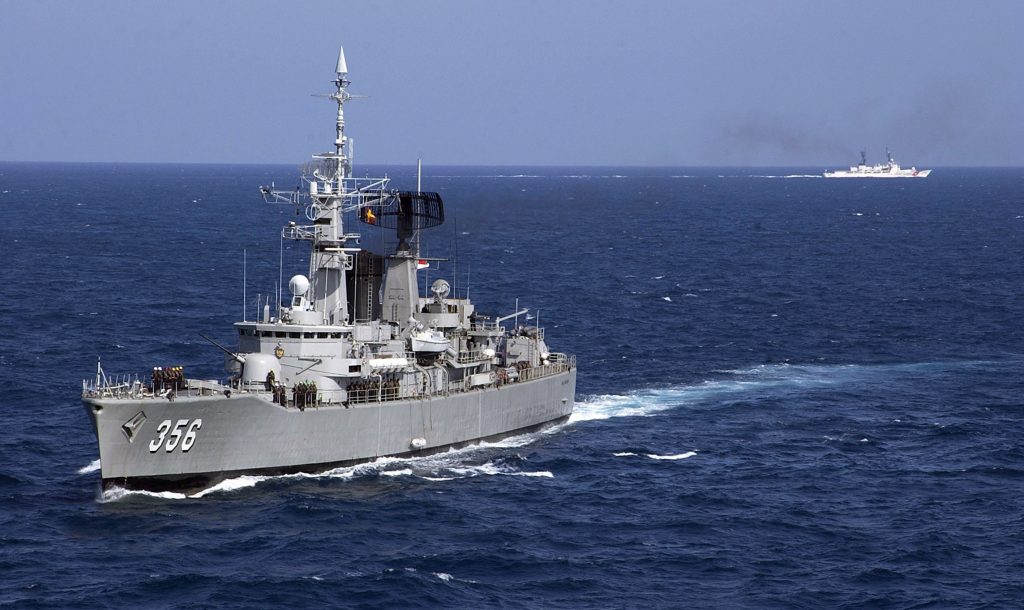With maritime tensions in the region remaining high, and likely to escalate further, Indonesia must reassess its Indo-Pacific strategy, Ristian Atriandi Supriyanto writes.
When asked to describe their country’s geography, Indonesians like to invoke the term posisi silang or ‘crossroad location’.
The term reflects the archipelago’s position straddling two continents – Asia and Australia – and two oceans – the Indian and Pacific. Conceived as early as the 1940s, the term has found new momentum in the narrative of President Joko Widodo’s ‘Global Maritime Fulcrum’ (Poros Maritim Dunia) concept introduced at the time of his election in late 2014.
The term ‘crossroad location’ encapsulates Indonesia’s spatial imagination, or ‘mental map’, of the world. From a purely geographical perspective, the term concisely describes Indonesia’s physical location between the Indian and Pacific oceans. But through a spatial lens, the ‘crossroad location’ term reveals very little about the Indian Ocean’s place in Indonesia’s strategic thinking, especially in comparison to the Pacific.
Instead, this mental map seems to blur, or even obscure, Indonesia’s Indian Ocean character. It conceals the reality that Indonesia has largely been a Pacific nation at the expense of its western frontier. Indonesia’s total trade with China, Japan, South Korea and Hong Kong in 2012 was more than double its trade with India, Australia, Europe, the Middle East and Africa combined. Most of its population and naval bases face the Pacific side of the archipelago. This simple fact naturally predisposes Indonesia’s strategic attention towards the Pacific and relegates the Indian Ocean to a backwater that elicits only occasional blips of awareness, such as the hijacking of the Indonesian-flagged MV Sinar Kudus in 2011 by Somali pirates.
Widodo’s Global Maritime Fulcrum seeks to raise Indonesia’s awareness of the Indian Ocean. Thus far, it has mainly been defined through Indonesia’s Indian Ocean Rim Association (IORA) chairmanship for the period 2015 to 2017. IORA presents Indonesia with the opportunity to demonstrate the heft of its ‘maritime diplomacy’, one of the Fulcrum’s five pillars. Four agendas guide Indonesia’s IORA leadership: the formulation of the IORA Concord; the implementation of a one-time inaugural IORA Summit and Blue Economy Conference in 2017; the establishment of an Indian Ocean Business Innovation Centre; and a consistent campaign for the empowerment of women.
Among these agendas, diplomatic and economic issues appear to dominate. The IORA Concord resonates quite strongly with the 1976 ASEAN Concord as part of which the five original members agreed on a Treaty of Amity and Cooperation (TAC). The Concord is conceived as a ‘code of conduct’ to ‘strengthen regionalism in the Indian Ocean’. When adopted in 2017, the Concord will ‘be a milestone reflecting 20 years of IORA achievements’ and, obviously, a diplomatic win for Indonesia.
The Third Indian Ocean Dialogue in April 2016 also provided an opportunity for Indonesia to air its concerns over illegal fishing. Although Indonesia adopted the controversial measure of sinking seized illegal fishing vessels, the promotion of IORA’s Blue Economy initiatives, aimed partly at promoting sustainable fishing, constitute a better long-term solution.
Given its diverse membership, IORA will nonetheless face difficulties in reaching, let alone implementing, binding commitments. Like the ASEAN Treaty of Amity and Cooperation, the IORA Concord would only commit IORA members to bland diplomatic statements that have little restraining force over signatories’ behaviours. It’s also obvious that the language of the draft would need to accommodate the diverse interests and priorities of IORA members. What IORA can do most in the security arena is promote maritime confidence-building measures, such as naval diplomacy, in coordination with the Indian Ocean Naval Symposium.
Absent from these agendas is Indonesia’s own strategy in response to, and in anticipation of, more intense competition between the major powers in the Indian Ocean. Of paramount concern is the safety and security of three maritime chokepoints – the Straits of Malacca, Sunda, and Lombok – which form Indonesia’s approaches to the Indian Ocean. As China and India expand their maritime power so too will their ability to project force throughout the Indo-Pacific increase, including in these chokepoints, alongside the US and some European nations.
Both India and the US have reported an increased presence of Chinese submarines in the Indian Ocean. While these submarines are officially deployed in counter-piracy operations they also conduct ‘area familiarisation’ and, according to the US Department of Defence, demonstrate “an emerging capability both to protect China’s SLOCs [sea lines of communications] and to increase China’s power projection into the Indian Ocean.” Increased foreign military traffic along the chokepoints could heighten Indonesia’s sensitivity over its maritime sovereignty. Worse, it could increase the risk of collisions or incidents between military units whose governments might already have contentious relations with one another.
What the strategy would be to respond to such a scenario, should it arise, remains to be seen. There is no doubt however that it would eventually require strong domestic political support. Unfortunately, the Global Maritime Fulcrum itself is facing criticism for being poorly understood by the relevant government ministries and agencies. The challenge, therefore, begins at home where success or failure could critically determine Indonesia’s Indian Ocean future.
Ristian Atriandi Supriyanto is an Indonesian Presidential PhD Scholar with the Strategic and Defence Studies Centre at the Australian National University.
This article is a collaboration between New Mandala and Policy Forum — Asia and the Pacific’s leading platform for policy analysis and debate.
 Facebook
Facebook  Twitter
Twitter  Soundcloud
Soundcloud  Youtube
Youtube  Rss
Rss 